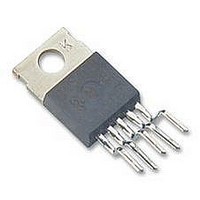LM2586T-ADJ National Semiconductor, LM2586T-ADJ Datasheet - Page 25

LM2586T-ADJ
Manufacturer Part Number
LM2586T-ADJ
Description
DC/DC Converter IC
Manufacturer
National Semiconductor
Specifications of LM2586T-ADJ
Input Voltage
40V
Output Voltage
37V
No. Of Pins
5
Termination Type
Through Hole
Mounting Type
Through Hole
Output Current Max
3A
Peak Reflow Compatible (260 C)
No
Supply Voltage Max
40V
Lead Free Status / RoHS Status
Contains lead / RoHS non-compliant
Available stocks
Company
Part Number
Manufacturer
Quantity
Price
Company:
Part Number:
LM2586T-ADJ
Manufacturer:
NS
Quantity:
500
Application Hints
CIRCUIT LAYOUT GUIDELINES
As in any switching regulator, layout is very important. Rap-
idly switching currents associated with wiring inductance
generate voltage transients which can cause problems. For
minimal inductance and ground loops, keep the length of the
leads and traces as short as possible. Use single point
grounding or ground plane construction for best results.
Separate the signal grounds from the power grounds (as in-
dicated in Figure 45 ). When using the Adjustable version,
physically locate the programming resistors as near the
regulator IC as possible, to keep the sensitive feedback wir-
ing short.
HEAT SINK/THERMAL CONSIDERATIONS
In many cases, a heat sink is not required to keep the
LM2586 junction temperature within the allowed operating
temperature range. For each application, to determine
whether or not a heat sink will be required, the following must
be identified:
1) Maximum ambient temperature (in the application).
2) Maximum regulator power dissipation (in the application).
3) Maximum allowed junction temperature (125˚C for the
LM2586). For a safe, conservative design, a temperature ap-
proximately 15˚C cooler than the maximum junction tem-
perature should be selected (110˚C).
4) LM2586 package thermal resistances
in the Electrical Characteristics).
Total power dissipated (P
as follows:
V
N is the transformer turns ratio, D is the duty cycle, and I
is the maximum load current (and I
maximum load currents for multiple-output flyback regula-
tors). The duty cycle is given by:
IN
is the minimum input voltage, V
D
) by the LM2586 can be estimated
(Continued)
OUT
LOAD
is the output voltage,
JA
is the sum of the
and
JC
(given
LOAD
25
where V
typically 0.5V for Schottky diodes and 0.8V for fast recovery
diodes. V
found in the Characteristic Curves.
When no heat sink is used, the junction temperature rise is:
Adding the junction temperature rise to the maximum ambi-
ent temperature gives the actual operating junction tempera-
ture:
If the operating junction temperature exceeds the maximum
junction temperatue in item 3 above, then a heat sink is re-
quired. When using a heat sink, the junction temperature rise
can be determined by the following:
Again, the operating junction temperature will be:
As before, if the maximum junction temperature is exceeded,
a larger heat sink is required (one that has a lower thermal
resistance).
Included in the Switchers Made Simple
a more precise (non-linear) thermal model that can be used
to determine junction temperature with different input-output
parameters or different component values. It can also calcu-
late the heat sink thermal resistance required to maintain the
regulator junction temperature below the maximum operat-
ing temperature.
To further simplify the flyback regulator design procedure,
National Semiconductor is making available computer de-
sign software to be used with the Simple Switcher
switching regulators. Switchers Made Simple is available
on a 3
tional Semiconductor sales office in your area or the National
Semiconductor
(1-800-272-9959).
1
⁄
2
F
" diskette for IBM compatible computers from a Na-
SAT
is the forward biased voltage of the diode and is
T
J
is the switch saturation voltage and can be
= P
D
• (
Customer
T
T
T
J
JC
J
J
= T
= T
= P
+
D
Interface
J
J
+ T
•
+ T
JA
A
A
.
Response
.
+
®
Heat Sink
design software is
www.national.com
)
®
Center
line of











